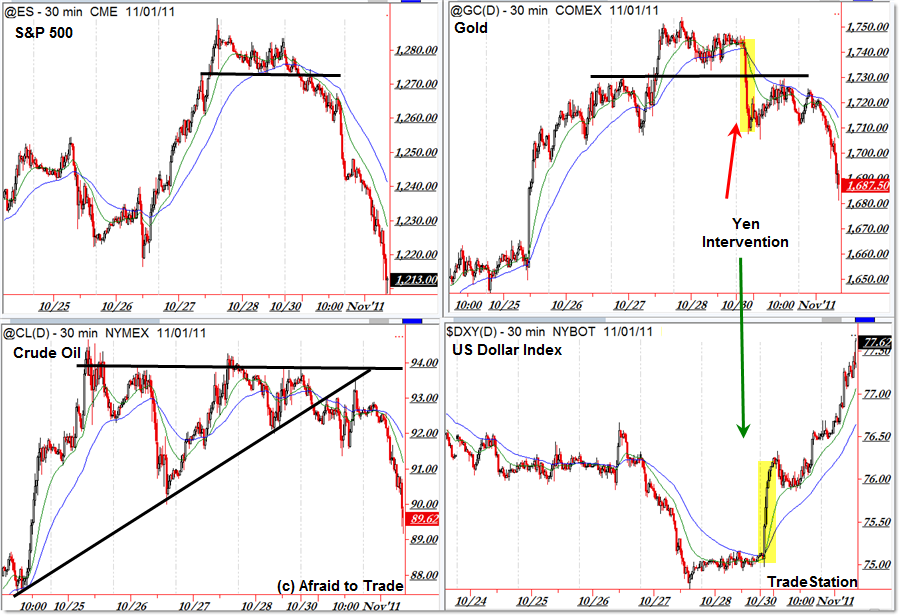Quick Charting the Intermarket Rise and Fall into November
With the sharp rise in volatility in the cross-market landscape – mainly driven by Greece’s bailout then walked-back with the surprise announcement of a referendum vote – let’s take a quick look at where the current intermarket landscape resides at the moment.
Click for larger image.
To recap, Thursday (October 27th) gave us a positive resolution of the Greece situation, and the cross-market landscape took on a sudden “Risk-On” environment.
This was coupled with an announcement of 2.5% GDP Growth in the United States, which greatly decreased fears of a “Double-Dip” Recession.
Those were your two “Double-Whammy” bullish news stories among other headlines of the day.
Fast-forward to Monday, October 31st where the Bank of Japan intervenes to force the Yen lower (seen best in the chart of Gold and the US Dollar Index above).
Also on Monday morning, we learn that prime broker MF Global has declared bankruptcy and was barred from the trading floor.
And overnight – going into November 1st – we receive word that Greece has decided to hold a referendum on the bail-out package, which was an “out-of-the-blue” event that sent traders selling first and asking questions later, driving a sharp and severe “Risk-OFF” trade which is where we open November.
With quick commentary on the charts above:
Oil remained stable, compressing between $92 and $95 over the last week only to collapse this morning
The S&P 500 experienced a sharp rise – driven by US GDP and Europe’s announcements – only to see the rise evaporate this week
Gold rose sharply above $1,700 into $1,750’s target and sold-off on the Yen Intervention and is declining further today (“sell first, ask questions later”)
Bonds (not seen in the four charts above) rallied higher after an initial sell-signal as yields fell (“Risk Off”)
Finally the US Dollar Index, after triggering a sell-signal under 76, reversed with the Intervention from the Bank of Japan, and further benefits from a “Risk-Off” environment and the harsh sell-off in the Euro on fears Greece might reject the bail-out plan.
The current market is driven to a larger extent than normal by headlines and volatility remains high – and volatility doesn’t just mean “downside action” – we’re seeing violent moves to the upside AND the downside, making it worth-while to adjust accordingly which often includes reducing position size and dropping to lower timeframes than normal.
Be safe.
Corey Rosenbloom, CMT
Afraid to Trade.com
Follow Corey on Twitter: http://twitter.com/afraidtotrade
Corey’s new book The Complete Trading Course (Wiley Finance) is now available!


I don't know how much more the market can feel good when there's nothing to feel good about. I think we 're being setup for early Jan. But , always good to read here Corey.
Sim
http://mcx-advisory.blogspot.c…